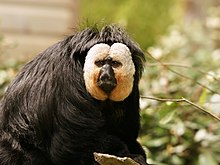Loading AI tools
Family of mammals From Wikipedia, the free encyclopedia
The Pitheciidae (/pɪθɪˈsaɪ.ɪdiː/) are one of the five families of New World monkeys now recognised. Formerly, they were included in the family Atelidae. The family includes the titis, saki monkeys and uakaris. Most species are native to the Amazon region of Brazil, with some being found from Colombia in the north to Bolivia in the south.
| Pitheciidae[1] | |
|---|---|
 | |
| White-faced saki (Pithecia pithecia) | |
 | |
| Black-fronted titi (Callicebus nigrifrons) | |
| Scientific classification | |
| Domain: | Eukaryota |
| Kingdom: | Animalia |
| Phylum: | Chordata |
| Class: | Mammalia |
| Order: | Primates |
| Suborder: | Haplorhini |
| Infraorder: | Simiiformes |
| Parvorder: | Platyrrhini |
| Family: | Pitheciidae Mivart, 1865 |
| Type genus | |
| Pithecia Desmarest, 1804 | |
| Genera (extant) | |
Pitheciids are small to medium-sized monkeys, ranging from 23 cm in head-body length for the smaller titis, to 44–49 cm for the uakaris. They have medium to long fur, in a wide range of colors, often with contrasting patches, especially on the face.
They are diurnal and arboreal animals, found in tropical forests from low-lying swamp to mountain slopes. They are predominantly herbivorous, eating mostly fruit and seeds, although some species will also eat a small number of insects. Sakis and uakaris have a diastema between the canine and premolar teeth, but the titis, which have unusually small canines for New World monkeys, do not.[2] All species have the dental formula: 2.1.3.32.1.3.3
Females give birth to a single young after a gestation period of between four and six months, depending on species. The uakaris and bearded sakis are polygamous, living in groups of 8-30 individuals. Each group has multiple males, which establish a dominance hierarchy amongst themselves. The titis and Pithecia sakis, by contrast, are monogamous and live in much smaller family groups.[2]
There are 54 currently recognized extant species of pitheciid monkey, grouped into two subfamilies and six genera.[1][3] Eleven extinct genera known from the fossil record are placed in the family, extending the age of the family to the Miocene.[4][5]
*Newly described species.[3] †Extinct taxa.
Silvestro etal 2017 showed the relationship among the extinct and extant pitheciid genera:[5]
| stem Pitheciidae |
| ||||||||||||||||||||||||||||||||||||||||||||||||||||||||||||||||||||||||||||||||||||||||||||||||
Seamless Wikipedia browsing. On steroids.
Every time you click a link to Wikipedia, Wiktionary or Wikiquote in your browser's search results, it will show the modern Wikiwand interface.
Wikiwand extension is a five stars, simple, with minimum permission required to keep your browsing private, safe and transparent.